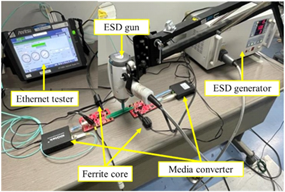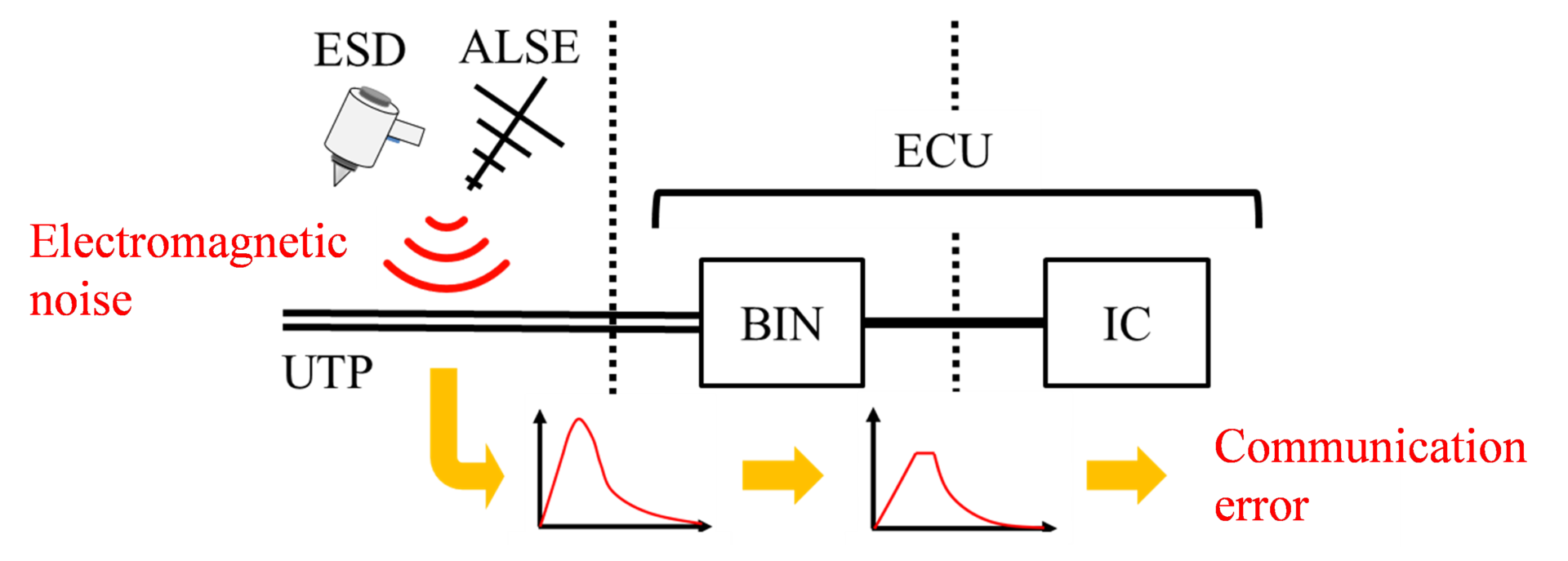1. Wireless Body Area Communication
With the rapid progress of small electronic devices and wireless communication technology, wireless body area networks (WBAN) have drawn considerable attention in medical services and healthcare applications. WBANs are divided into wearable BAN and implant BAN. Wearable BAN is based on on-body communication which aims to monitor a person’s healthy situation in daily life, whereas implant BAN is based on in-body communication which aims to transmit medical data or image from the inside to outside of human body such as capsule endoscopes. Possible frequency bands for WBAN include 10-50 MHz human body communication (HBC) band, 400 MHz band, 2.4 GHz band and UWB.

In our laboratory, we are focusing on HBC band, 400 MHz band and UWB to tackle the following research topics:
- On-body / in-body channel modeling
- On-body / in-body modulation and de-modulation schemes
- Localization and tracking of in-body communication device for capsule endoscope
- Development of various body area transceivers and their feasibility measurement
【Topic 1】
- Real-Time Transmission of Vital Signals by Human Body Communication Technology
One of promising applications is to monitor driver’s health conditions for assisting automatic drive. In this scenario, some vital sensors are placed on the driver’s body to collect healthcare data such as electrocardiogram (ECG), blood pressure and pulse rate. The vital sensors may be embedded in the driver’s seat, seat belt, or steering wheel to make the driver unconsciously wear these sensors. A HBC transceiver is used to send these data to a control unit for analyzing the driver’s health condition and generate warning signs or make automatic control of car, if necessary, for safety driving. As an element technology, we have developed an impulse radio (IR) type HBC transceiver for ECG signal real-time transmission:
- The electrodes act simultaneously for both ECG signal detection and HBC transmission
- Wideband IR scheme with OOK modulation, high speed transmission at 1.2 Mbps
- No carrier required, CMOS structure, small size and low power consumption
- Meet the Extremely weak radio law in Japan, no license required, high security
 |  |

【Topic 2】
- Development of High-Speed Wideband IR Transceiver for Capsule Endoscope Application
We have developed two in-body transceivers in the UWB low-band and the HBC band, respectively, for real-time image/video transmission of wireless capsule endoscope. The transceivers employ a wideband impulse radio (IR) technology with multiple pulse position modulation (MPPM) scheme. From a living animal experiment under the support of medical doctors in a hospital, our developed transceivers have demonstrated a bit error rate of 10-2 at an in-body depth of at least 12 cm at a data rate as high as 1 Mbps.
①. 3.4-4.8GHz UWB Low Band Transceiver
- IR scheme with multiple PPM
- High-speed communication available at a depth of at least 12 cm at 1 Mbps
- Feasibility validated with pig for in-body communication
- Diversity reception technology developed for performance improvement
②. 10-50MHz HBC Band Transceiver
- IR scheme with OOK modulation
- Implant antenna miniaturization with magnetic material (1cm x 2cm)
- High-speed communication available at a depth of at least 26 cm at 1 Mbps
 |  |
 |  |
【Topic 3】
- Wirelessization of control signal transmission to myoelectric hand
We developed a wireless technique for sending the control signal to a myoelectric artificial hand based on human body communication (HBC). First, a detection circuit detects the myoelectric signals by using three electrodes attached to the arm. Then the detected myoelectric signals are transmitted to a myoelectric hand control unit by a HBC-based transceiver. The myoelectric hand are thus controlled and operated based on the received myoelectric signals.
Technical features:
- Adoption of extremely weak radio station frequency band (10 – 50 MHz)
- High-speed transmission up to 10 Mbps by employing impulse-radio (IR) type multi-pulse position modulation (MPPM)
- Low energy consumption because of direct pulse transmission without carrier signal
- High immunity to electromagnetic noise and interference especially electrostatic discharge (ESD)
- Available to be used in various human-body-wearing robots and human-body around robots
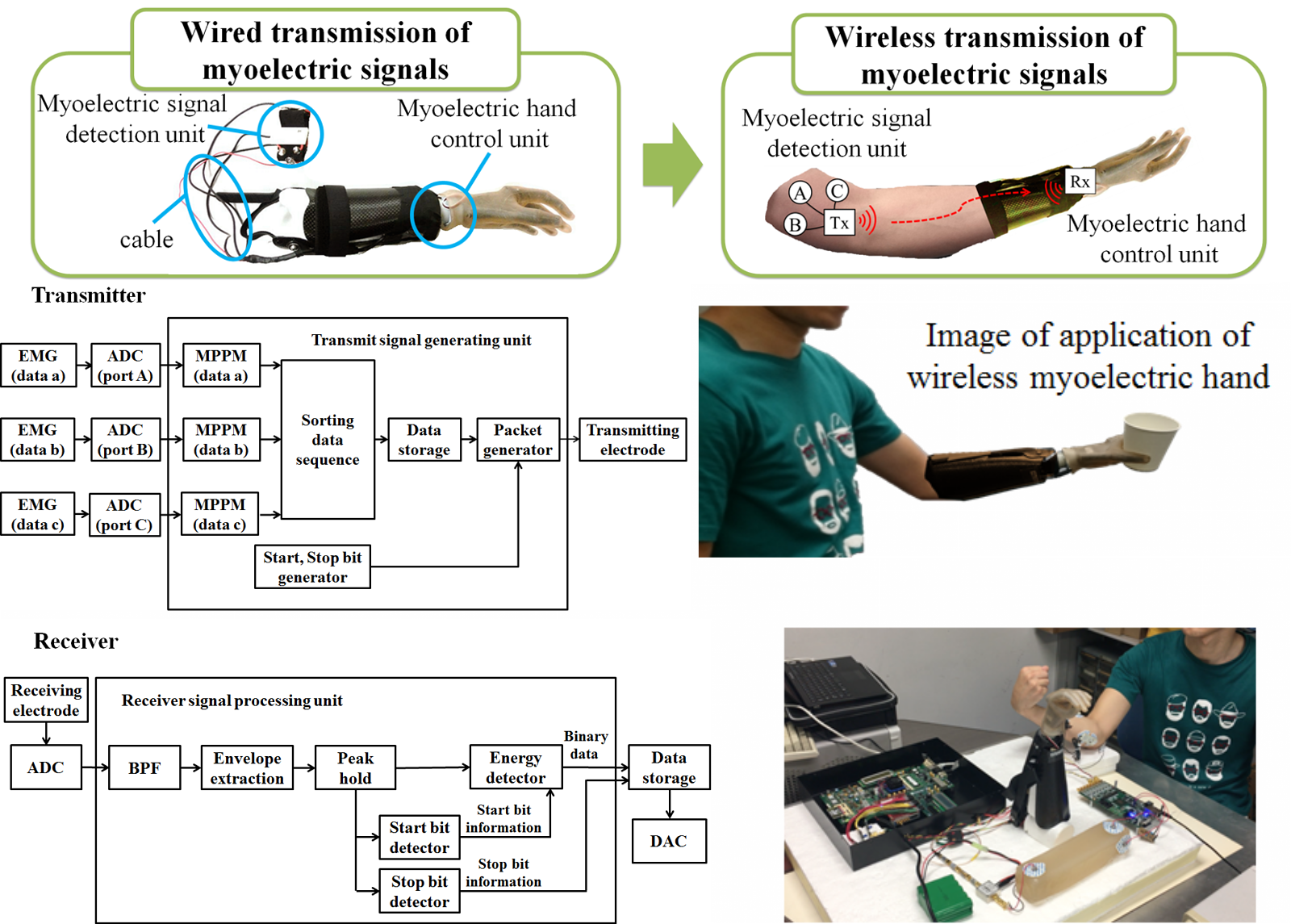 |
【Topic 4】
- Localization/Tracking Methods for Capsule Endoscope
It is important to estimate the location of implant communication devices, i.e., wireless capsule endoscope, because no one knows the location in advance due to its movement inside a human body. Therefore, we have developed location tracking methods with radio frequency signals transmitted from the capsule endoscope.
①. RSSI-based location tracking methods with 400MHz band
- Statistical model of RSSI variation for 400 MHz band in-body BAN
- RSSI-based Tracking method with particle filter
- Achievable estimation accuracy of less than 1cm
②. Joint TOA/RSSI-based localization with UWB low band
- Mathematical expression for relative permittivity estimation based on TOA and RSSI
- Localization algorithm without pre-knowledge about relative permittivity structure of a human body


2.In-vehicle communication EMC
Automotive electronic control systems, such as autonomous driving and connected cars, have advanced significantly, and besides, high reliability and safety are required for automotive systems. To meet the requirements, ensuring electromagnetic compatibility (EMC) performance that prevents the generation of unwanted noise and the occurrence of malfunctions due to noise is crucial. However, as the advancement of device technology and the communication between devices have evolved, there is an increasing amount of noise generated by devices, and communication frequencies have shifted towards higher frequencies. Consequently, EMC design becomes more challenging.
Our laboratory collaborates with Center for Future Communication Research at Nagoya Institute of Technology to conduct research aimed at establishing EMC design and evaluation techniques for automotive communication, which is a critical component of automotive systems. Additionally, we take part in international standardization activities.
Center for Future Communication Research at Nagoya Institute of Technology: http://cfcr.web.nitech.ac.jp/english/emc_en.html
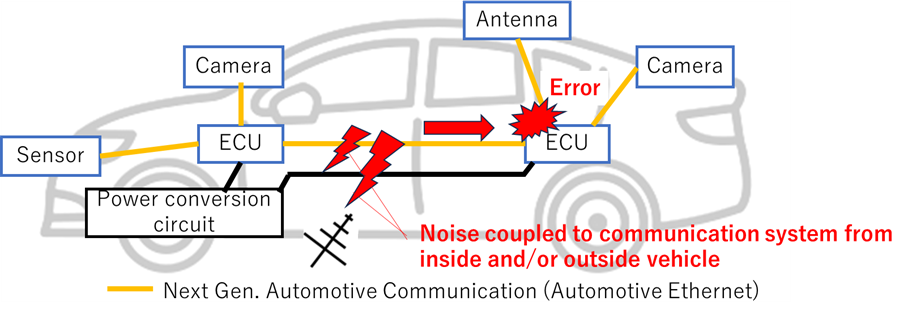
【Topic 6】
- Research on Novel EMC Evaluation System
When evaluating EMC performance of automotive communication systems, EUT may show different performance due to differences in the evaluation environment. Therefore, we focus on the difference between the actual vehicle environment and a standard evaluation environment that simulates the vehicle one. We analyze the factors that cause changes in the coupling and propagation of noise, and research to reduce these factors. We are also studying novel measurement methods to accurately evaluate the high-frequency characteristics of evaluation systems.
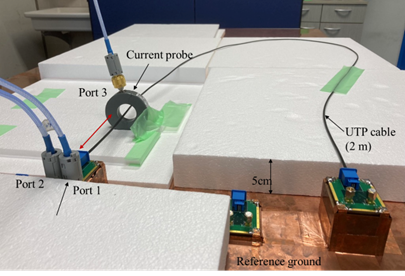

【Topic 7】
- Evaluation and Measurement Methods for EMC Devices of Automotive Communication
Common-mode chokes and ESD protection devices used in EMC design are required to have high EMC and communication characteristics. Therefore, it is needed to establish reliable evaluation methods for high-frequency characteristics. Our laboratory researches the optimization of test jigs and test equipment and the development of new evaluation methods to improve EMC design and evaluation technologies. We also contribute to the improvement through international standardization activities in IEC, OPEN Alliance, and other organizations.
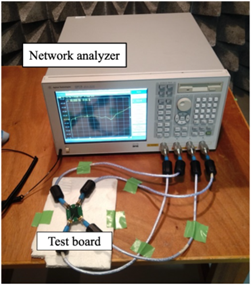
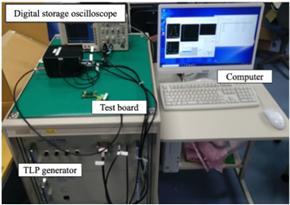
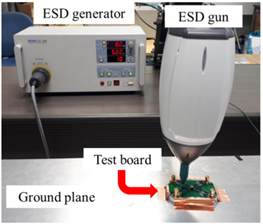
【Topic 8】
Research on Influence of High Frequency Noise on Communication Quality of Automotive Ethernet
To ensure the EMC design of automotive communication, it is necessary to clarify the mechanism of communication errors caused by noise. Our laboratory, we analyze the coupling and propagation of injected noise to communication lines and the resulting communication errors from both actual measurements and simulations.
